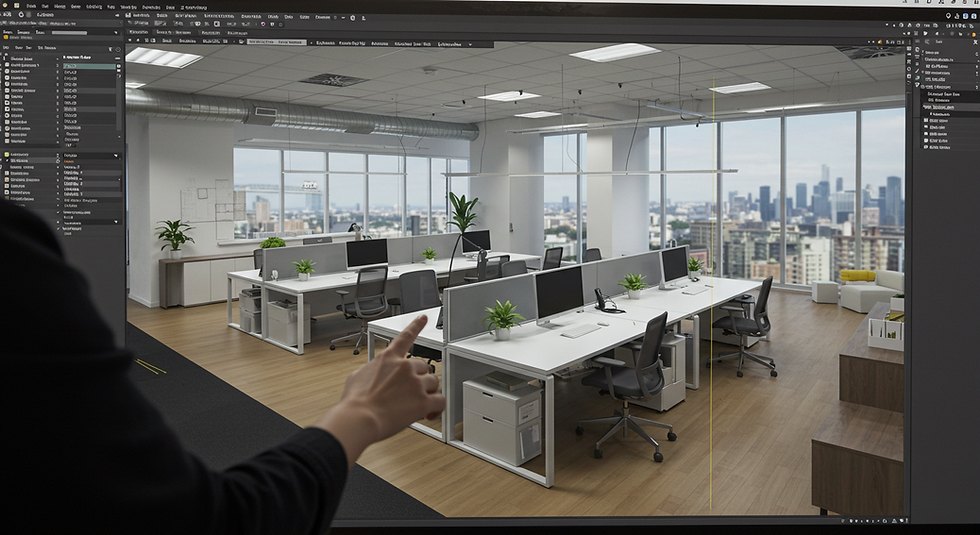The Role of Technology in Modern Commercial Renovations
- Weiliang
- Aug 22
- 3 min read
Updated: Sep 2
Technology is changing the way commercial renovations are done in Singapore. From planning to execution, innovative tools make the process faster, more accurate, and cost-effective. Modern businesses are using digital designs, smart systems, and automated solutions to create functional, stylish, and efficient office spaces. This guide explores how technology is shaping contemporary commercial renovations and why it’s essential for today’s workplaces.
Digital Planning and 3D Modelling

One of the biggest technological advancements in commercial renovation is digital planning using 3D modelling software. Architects and designers can create detailed virtual models of your office space, allowing you to visualise layouts, colours, and materials before construction begins. This reduces the risk of costly mistakes and enables more precise planning. You can make design adjustments in real time and see how changes will affect the overall workspace.
Use Project Management Tools
Renovations involve multiple contractors, suppliers, and schedules. Project management software helps coordinate all aspects of a renovation efficiently. Tools can track timelines, manage budgets, and assign tasks to smooth communication between teams. This reduces delays and keeps the project on track, making the renovation process more predictable and transparent.
Smart Office Technology
Modern commercial renovations often integrate smart office technology. This includes automated lighting, climate control systems, and energy-efficient appliances. Smart systems not only improve comfort and productivity but also reduce energy consumption. For instance, motion-sensor lighting that uses electricity is used only when needed, cutting costs while supporting sustainability initiatives.
Virtual Reality (VR) and Augmented Reality (AR)
VR and AR technologies are increasingly popular for commercial renovations. VR allows clients to take a virtual tour of the office before any physical work begins, providing a realistic sense of space and design.AR can be used on-site to overlay design plans on the existing structure, helping contractors visualise changes and identify potential issues. These technologies minimise errors, save time, and improve client satisfaction.
Building Information Modelling
Building Information Modelling (BIM) is a technology that integrates all aspects of construction and design into a single digital model. It includes structural, electrical, plumbing, and HVAC systems. BIM allows teams to detect conflicts, optimise layouts, and plan maintenance efficiently. Using BIM reduces project costs and provides a long-term reference for facility management.
Sustainable and Energy-Efficient Solutions
Technology also enables the implementation of sustainable solutions during renovations. Energy-efficient lighting, smart thermostats, and automated HVAC systems reduce environmental impact and operational costs. Monitoring systems track energy consumption, allowing businesses to adjust usage and save on utilities. These innovations make offices more sustainable, aligning with modern corporate social responsibility standards.
High-Quality Materials and Fabrication
Modern technology has improved the production and fabrication of building materials. CNC machines, 3D printers, and laser cutters allow for the precise manufacturing of custom furniture, wall panels, and fixtures. This level of precision ensures high-quality finishes and reduces waste. Businesses can achieve a stylish and functional workspace without compromising sustainability or efficiency.
Data-Driven Design Decisions
Modern technology allows data collection on space utilisation, lighting, and workflow. Analysing this data helps businesses design spaces that are more efficient and employee-friendly.For example, tracking which areas are underused can inform layout adjustments and maximum space efficiency. Technology helps make informed design decisions that improve productivity and employee satisfaction.
Cost and Time Efficiency
Technology streamlines communication, planning, and construction processes, leading to significant time and cost savings. Virtual simulations, project management tools, and automated systems reduce human error and resource waste . These efficiencies allow businesses to complete renovations faster and within budget, without compromising on quality or sustainability. For businesses starting their planning journey, exploring practical guides such as Tips to Budget for Your Commercial Renovation can be especially helpful in managing finances effectively.
Conclusion
Technology is transforming commercial renovations, making them faster, more precise, and smarter for businesses in Singapore. Tools like digital planning, VR visualisations, and smart office systems improve workflow, reduce errors, and support sustainable practices. Working with an interior design specialist lets your renovation take advantage of the latest technology while meeting your design goals. These tools help businesses create modern, efficient offices that boost productivity and leave a positive impression on clients.
FAQs
1. How can technology improve commercial renovation projects?
Technology enhances design accuracy, streamlines project management, reduces errors, and enables smart, energy-efficient office solutions.
2. What is the benefit of using VR and AR in renovations?
VR provides virtual tours before construction, and AR overlays design plans on-site, helping visualise changes and identify potential issues early.
3. Why use an interior design specialist in Singapore?
Specialists integrate technology effectively, select appropriate materials and layouts, and ensure your renovation is functional, stylish, and sustainable.
4. How does Building Information Modelling (BIM) help?
BIM consolidates all aspects of design and construction in a digital model, allowing conflict detection, efficient planning, and long-term maintenance management.
5. Can smart office technology save costs?
Yes. Automated lighting, climate control, and energy-efficient appliances reduce electricity consumption and operational expenses over time.



Comments